#battistero neoniano
Explore tagged Tumblr posts
Text





Battistero Neoniano (the Baptistery of Neon), built in the 4th or 5th century in Ravenna, Italy.
Explore:
#mosaic#ancient art#ancient history#baptistery#travel#history#architecture#church architecture#historical architecture#ancient rome#classical antiquity#urbanexploration#original photography#photographers on tumblr#lensblr#photography#italy#italia#ravenna#wanderingjana
22 notes
·
View notes
Text
Gita #1 Ravenna
È iniziata con un treno preso all’ultimo secondo, con il sorriso più bello che potessi immaginare davanti la stella di Lucio Dalla mangiando tortelli, che è proseguita con una delle più grandi delusioni della mia vita, mitigata dalla bellezza dell’arte, che non salverà il mondo, ma salva l’animo delle persone che la sanno guardare.
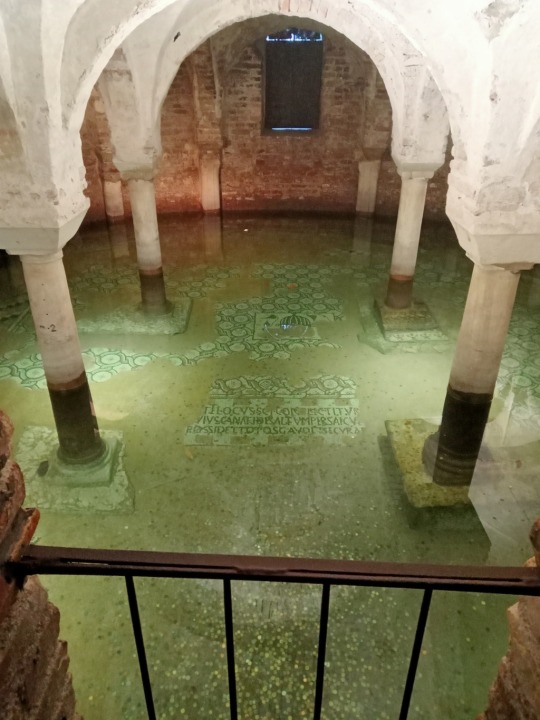
Cripta della Basilica di San Francesco (IX-X secolo), Ravenna, che per il fenomeno della subsidenza è scesa a 2,7 metri sotto il livello del mare.
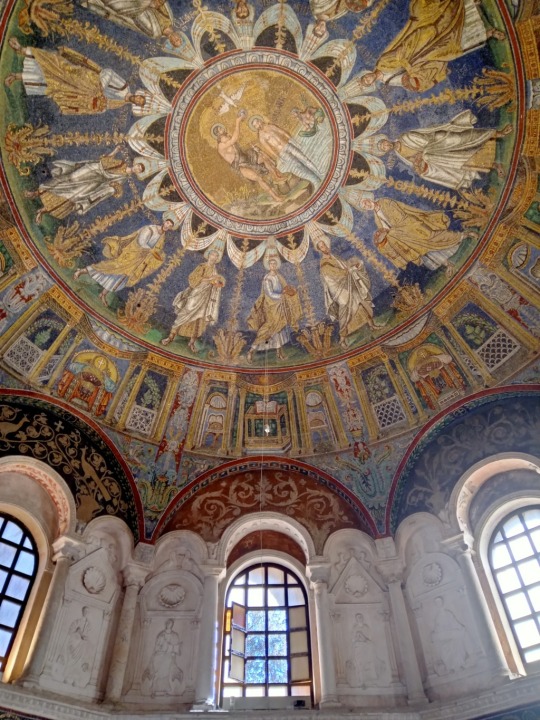
Mosaici del Battistero Neoniano, V secolo d.C., il primo caso documentato di Gesù nudo durante il battesimo.

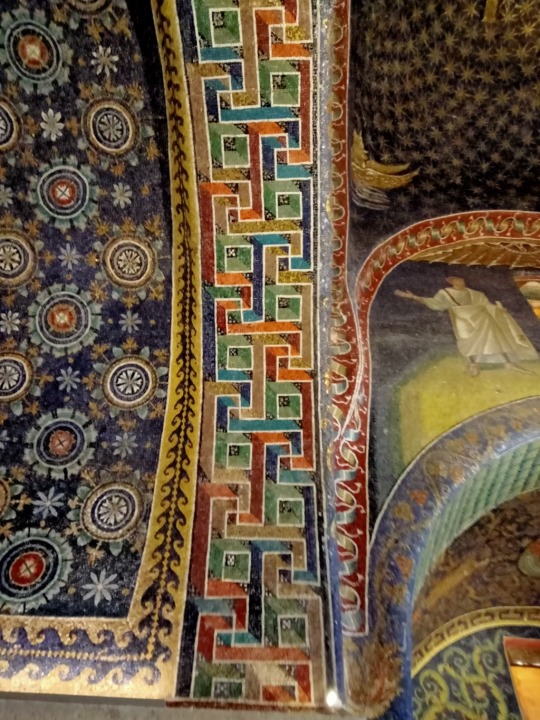
Mosaici al Mausoleo di Galla Placidia, V secolo d.C.

Basilica di San Vitale, i Mosaici del V secolo con la cupola affrescata barocca, 1770 circa.


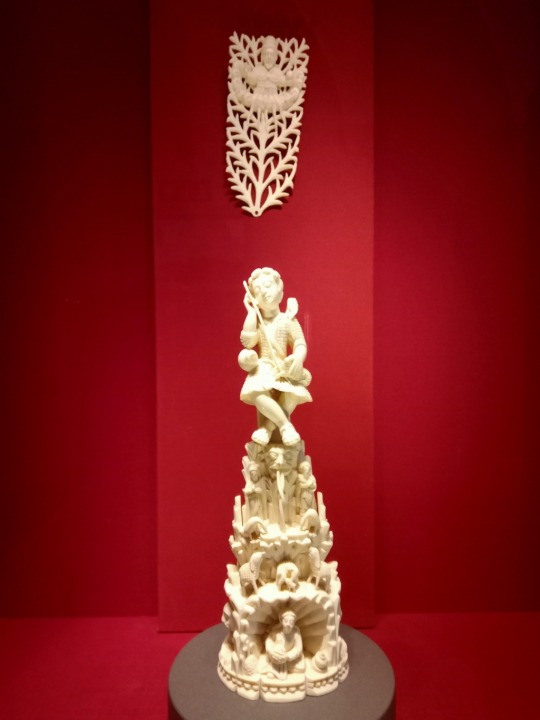
Meraviglie dal Museo Nazionale di Ravenna: ricami marmorei, ritrovati nei sepolcri del II-III secolo d.C.; spada di fabbricazione milanese del 1735; prezioso avorio con pettine da Goa, XVIII secolo.

I re Magi, Basilica di Sant’Apollinare Nuovo, con il berretto frigio, VI secolo d.C.
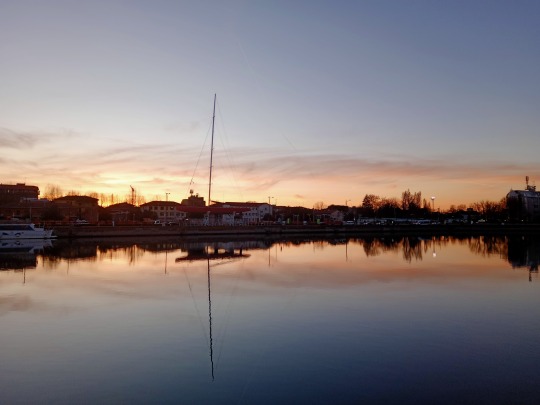
Tramonto sulla Darsena, Marzo 2023
35 notes
·
View notes
Text




mosaics of Ravenna (5th/6th century):
Mausoleo di Galla Placidia
Basilica di San Vitale
Battistero Neoniano
Basilica di Sant'Apollinare Nuovo
4 notes
·
View notes
Text
NOME: Battistero Neoniano
DATAZIONE: V secolo
DOVE: Ravenna
STRUTTURA: pianta centrale ottagonale, tiburio, 4 absidiole, cupola entro il tiburio.
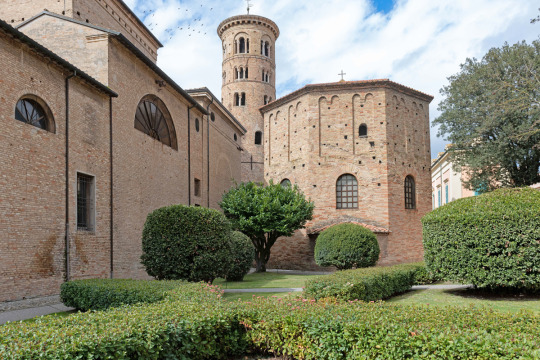
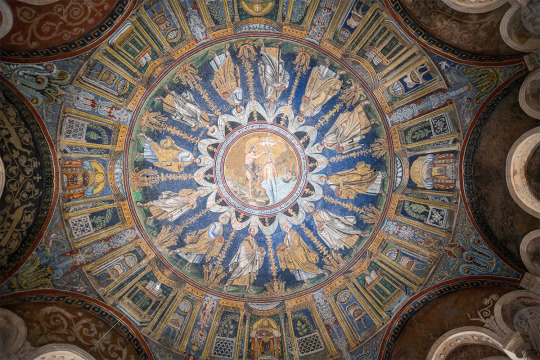
0 notes
Text
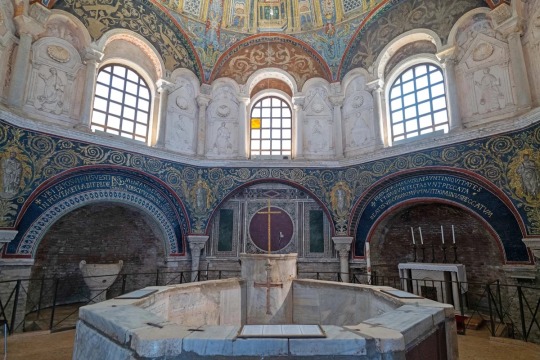
TITOLO: battistero neoniano
DATAZIONE: V secolo
DETTAGLI: costruito dietro iniziativa dell’episcopato di Orso, quando Ravenna divenne capitale dell’impero di Occidente. Fu poi ricostruito dal vescovo Neone(450-475 d.C.). Questo battistero è il meglio conservato a Ravenna. È di forma ottogonale e in muratura, ha i lati rettilinei e absidati, porte interrate e finestra con arco a tutto tondo. All’interno presenta una magnifica decorazione tripartita: marmi sul fondo, stucchi nella parte di mezzo e mosaici di tipo ellenistico-romano nella parte superiore. Il battistero e la sua decorazione è bella e luminosa, proprio per ricordare il passaggio dall’ombra delle tenebre alla luce di Dio. Presenta inoltre una cupola, che al centro presenta la scena di Cristo, all’interno delle acque del fiume Giordano, battezzato da Giovanni il Battista. Questa è la più antica testimonianza di una scena di battesimo del Salvatore in un mosaico.
0 notes
Photo

Ceiling mosaic of the Baptistry of Neon in Ravenna. It depicts the baptism of Jesus in the Jordan River, with a personification of the river to the side of the scene. A procession of apostles proceeds around the mosaic in two directions, ending with Saint Peter meeting Saint Paul.
#baptistry of neon#battistero neoniano#ravenna#italy#italia#byzantine art#mosaic#late empire#apostles#baptism#baptism of christ#john the baptist#jesus christ#christianity
309 notes
·
View notes
Text

2021 Ravenna. Battistero Neoniano
0 notes
Photo

wooden box & plastic chairs in Battistero Neoniano built in 396 … picket field & plastic chairs #contemporaryintervention in Battistero Neoniano inbuilt 396 #unescoheritage #ravennamosaici
#battistero#built#chairs#contemporaryintervention#neoniano#plastic#ravennamosaici#unescoheritage#wooden
0 notes
Text

VI century’s Byzantine mosaic at Battistero Neoniano, Ravenna, Italy (site UNESCO)
#travelarim#slow travel#italy#architecture#hdr#church#mosaic#ravenna#romagna#unesco#byzantine#christianity#medieval#europe#art photography
8 notes
·
View notes
Text

Due esempi meglio conservati di battistero paleocristiano si trovano a Ravenna. Uno di questi è il Battistero ortodosso o neoniano di cui qui potete vedere l'interno. L'interno è decorato con rivestimenti in marmo, mosaici e stucchi.
1 note
·
View note
Text
Ravenna, Italy
After spending most of the past six months in Reggio, we decided it was time to see another town. Our English friend, Danielle, conveniently has a car and was keen for a small road trip! Wanting to go see something (not just a pretty small town) we determined the UNESCO Mosaics of Ravenna we’re a good starting point. And it’s only 1hr 45 from Reggio!

Ravenna has a very convenient free parking spot just outside the city center and a handy tourist map showing all the mosaic spots.

This is a town who knows why people are there and will very proudly remind you of their 7 UNESCO World Heritage Monuments at every turn. Mosaic stores, souvenir shops, plaques and mosaics on some of their main street signs.

For 10.50 you receive a combination ticket for the five main monuments. While you can purchase the tickets at any of the sites, I highly recommend not buying them at the biggest church- San Vitale. The line there was super long while there wasn’t even a line where we started our adventure at Museo e Cappella Arcivesovile which is also the closest location to the free parking lot.

The Museo is nice enough. It’s main thing is marble. It’s full of marble pieces from the first cathedral church and chapel of Sant’Andrea. As well as having other Christian relics dating as far back to 4th and 5th centuries. There is a Paschal calendar which charts the date of Easter from 532 AD- 626AD.

An Ivory Cathedra or bishop’s seat from the Byzantine era

which is considered to be among the finest pieces of ivory carving in Western art. Hence the glass protecting it from the small children.

Most of the other pieces weren’t protected at all and simply relied on human decency.

The museum also has the private chapel of the bishop built at the end of the 5th century. The beautiful mosaics featuring Jesus, the apostles and the waterfowl of Ravenna were a quiet place for the bishop to contemplate.

In each of the places we visited I was struck by the complexity of the mosaics. In the fragments housed in the museum you could get up close and really appreciate all the tiny colored stones to make these immense artworks.

The craft and precision involved is quite impressive.

Our next stop is just outside the museum: Battistero Neoniano ( Baptistry of Neon). It’s the oldest monument in the city, erected on the site of an old Roman Bath. It began construction at the end of the 4th century and was finished by Bishop Neon at the end of the 5th. It was a baptismal tub in the center and the ceiling is covered in beautiful mosaics depicting John the Baptist baptizing Jesus along with a personification of the river Jordan.

The biggest monument in Ravenna and one of the most important surviving examples of early Christian Byzantine art and architecture in Euorpe is Basilica San Vitale. Begun in 526AD it was completed in 547. It’s a very impressive building giving the sense of solid permanence and winding lines.

It has some of the earliest examples of flying buttresses.

Though the ambulatory and gallery were vaulted in the Middle Ages and Baroque frescoes were added in the late 1700’s. The huge Byzantine mosaics are thought to be the largest and best preserved outside of Constantinople and they are stunningly impressive. When you enter the church you are immediately taken aback by the sheer size of the space and the volume of mosaics.

They are all rich colors, intriguing and interesting. You could probably sit and study this art for days and each day find something you hadn’t noticed before. It is so detailed.


The arch separating the dome from the mosaics depicts Jesus, the twelve Apostles and San Vitale’s two sons. There is also the depiction of Jesus seated on a blue globe offering the martyr’s crown to San Vitale along side depictions from all facets of the bible.

This ceiling is seriously impressive and just so immense it’s hard to take all of it in.

The details in everything, the color and the shine makes it seem new even though it is so ancient. Even the marble holding up the church is intricate.

There are some weird sides as well…mostly in the babies (cherubs?) like this demon child on the fresco, or this marble one.

But overall, take some time in this church. Constantly look for new details and appreciate the intricacy of design.

Just outside San Vitale is the Mausoleo di Galla Placida. A mausoleum that houses three sarcophagi. Thought to be built for Galla Placidia, the daughter for Roman Emperor Theodosius I. She died in 450 and along with her remains, there are also sarcophagi for her son (or brother) and her husband.

The mosaics are lit through alabaster shell windows and depict, among other Christian and apocalyptic symbols, garden of Eden plant and animal life.

The main ceiling is a starry night sky with a golden cross at the center. It’s amazing the trick of the mosaics in photos making it look almost convex instead of concave.

The geometry and visual art of the designs should be appreciated.

We wandered away from San Vitale through the heart of Ravenna. Aside from these ancient and monolithic monuments, the rest of the city has a quite modern feel. The buildings are not like your quintessential small Italian town. Lined with shops and restaurants it wasn’t a place I would go just to go. We did stop of a delicious gelato and our English friends happened upon a chips (fries) shop so of course they had to try it out. Through the main square and down some side streets we arrived at our final stop. The basilica of Sant’Apollinare Nuovo.

It’s a long hall of a church that was first constructed by King Theodoric the Great as his palace chapel in the 6th century. According to legend Pope Gregory the Great ordered the mosaics to be blackened as they distracted from prayer. It underwent further modernization/ reconstruction throughout the end of the 6th and 7th centuries with the destruction of the mosaic ceiling. It’s now a ornate wood pattern all the way through

But the mosaics on the sides of the ceiling were preserved. Although on some of them you can still see disembodied mosaic hands where the Byzantines blotted out praying Goths or members of Theodoric’s Court.

On one side there is a depiction of the 22 Virgins of the Byzantine period led by the Three Magi ( in fabulous leopard-skin pants) with their names Balthasaar, Melchior and Gasapr written above them. This is thought to be the earliest example of these names being assigned to the wise men in Christian art.

We ended our trip with a delicious sea-food lunch and headed back home. Although Ravenna itself is not very exciting it was very cool to see these ancient and well-crafted works of art. It’s something unique and somewhat unexpected from the exterior of the town and monuments. Plus getting outside of Reggio was a nice change and made us appreciate our little city all the more.
#ravenna#italy#italia#travel#adventure#mosaics#mosaics of ravenna#ravenna mosaics#art#history#expat#expat travels#travel abroad#travelbug#travelling#things to see#things to do in italy#off the beaten path italy#italian art#byzantine#longpost#tblogger
37 notes
·
View notes
Photo

Battistero neoniano - 2020 - Disposable camera
3 notes
·
View notes
Text



Lezione del 27/04/2020
AUTORE: sconosciuto
NOME: Battistero Neoniano (o Battistero degli Ariani)
DATA: V secolo d.C.
LUOGO: Ravenna
CONTESTO ORIGINALE: L'edificio, nel si amministrava il sacramento del battesimo, fu costruito dietro iniziativa del vescovo Neone.
SCELTE TECNICHE E STILISTICHE: La pianta, a terra quadrata, nell'alzato si sviluppa in un ottagono. Al centro dell'edificio troviamo il fonte battesimale, una vasca in marmo greco e porfido (ristrutturata nel 1500) in quanto il sacramento era amministrato per immersione. L'interno è ricco di tarsie di marmo e mosaici, in particolare la cupola (coperta all'estero da un tiburio) è decorata con la raffigurazione del battesimo di Gesù, circondata da una fascia nella quale sono rappresentati i 12 apostoli su sfondo blu. Ampie finestre al centro di trifore illuminano l'ambiente.
per maggiori approfondimenti: https://docs.google.com/document/d/1HmPWzyi1TDNgMVQYtsxC810gVylHGLhuAhvi79a43rQ/edit
2 notes
·
View notes
Photo

Nome: Battesimo di Cristo Autore: Sconosciuto Data: fine V - inizio VI sec. Collocazione: Battistero Ariano, Ravenna Tecnica e materiale: mosaico che riveste la cupola, tessere vitree Descrizione: Nel mosaico è raffigurato un giovane Cristo completamente nudo, imberbe e con i capelli lunghi, immerso per metà nelle acque del Giordano. S.Giovanni Battista posto sulla destra della raffigurazione gli impone la mano sul capo, mentre la colomba che simboleggia lo Spirito Santo fa scendere su Gesù l'acqua che porta nel becco. Sulla sinistra della scena si trova una figura con i capelli bianchi, avvolto sino alla cintola da un panno verde, con in mano una canna palustre e sulla testa chele di gamberi: è la personificazione del fiume Giordano. Come nel Battistero Neoniano, la scena del Battesimo di Cristo è circondata dal una teoria di Apostoli, ognuno dei quali è separato dall'altro da una palma stilizzata dalla quale pendono datteri.
2 notes
·
View notes
Photo

In the early fifth-century Baptistry of Neon, Ravenna.
#ravenna#baptistry of neon#battistero neoniano#ancient rome#byzantine art#byzantine empire#mosaic#marble#church architecture#italy#italia
159 notes
·
View notes



